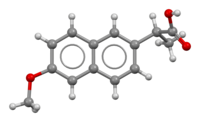 | |
 | |
| Clinical data | |
|---|---|
| Pronunciation | /nəˈprɒksən/ |
| Trade names | Aleve,Naprosyn,others[1][2] |
| AHFS/Drugs.com | Monograph |
| MedlinePlus | a681029 |
| License data | |
| Pregnancy category |
|
| Routes of administration | By mouth |
| ATC code | |
| Legal status | |
| Legal status | |
| Pharmacokinetic data | |
| Bioavailability | 95% (by mouth) |
| Protein binding | 99% |
| Metabolism | Liver (to 6-desmethylnaproxen) |
| Elimination half-life | 12–17 hours (adults)[7] |
| Excretion | Kidney |
| Identifiers | |
| |
| CAS Number | |
| PubChem CID | |
| DrugBank | |
| ChemSpider | |
| UNII | |
| KEGG | |
| ChEBI | |
| ChEMBL | |
| PDB ligand | |
| CompTox Dashboard (EPA) | |
| ECHA InfoCard | 100.040.747 |
| Chemical and physical data | |
| Formula | C14H14O3 |
| Molar mass | 230.263 g·mol−1 |
| 3D model (JSmol) | |
| Melting point | 152–154 °C (306–309 °F) |
| |
| |
| (verify) | |
Naproxen, sold under the brand name Aleve among others, is a nonsteroidal anti-inflammatory drug (NSAID) used to treat pain, menstrual cramps, and inflammatory diseases such as rheumatoid arthritis, gout and fever.[8] It is taken orally.[8] It is available in immediate and delayed release formulations.[8] Onset of effects is within an hour and lasts for up to twelve hours.[8] Naproxen is also available in salt form, naproxen sodium, which has better solubility when taken orally.[9]
Common side effects include dizziness, headache, bruising, allergic reactions, heartburn, and stomach pain.[8] Severe side effects include an increased risk of heart disease, stroke, gastrointestinal bleeding, and stomach ulcers.[8] The heart disease risk may be lower than with other NSAIDs.[8] It is not recommended in people with kidney problems.[8] Use is not recommended in the third trimester of pregnancy.[8]
Naproxen is a nonselective COX inhibitor.[8] As an NSAID, naproxen appears to exert its anti-inflammatory action by reducing the production of inflammatory mediators called prostaglandins.[10] It is metabolized by the liver to inactive metabolites.[8]
Naproxen was patented in 1967, and approved for medical use in the United States in 1976.[11][8][12] In the United States it is available over the counter and as a generic medication.[8][13] In 2022, it was the 88th most commonly prescribed medication in the United States, with more than 7 million prescriptions.[14][15]
- ^ Cite error: The named reference
drugswas invoked but never defined (see the help page). - ^ Cite error: The named reference
Naproxen internationalwas invoked but never defined (see the help page). - ^ "Naproxen Use During Pregnancy". Drugs.com. 13 August 2019. Retrieved 27 December 2019.
- ^ "FDA-sourced list of all drugs with black box warnings (Use Download Full Results and View Query links.)". nctr-crs.fda.gov. FDA. Retrieved 22 October 2023.
- ^ Gill, A, ed. (July 2013). Standard for the Uniform Scheduling of Medicines and Poisons No. 4 (PDF). Therapeutic Goods Administration. ISBN 978-1-74241-895-7.
- ^ "Boots Period Pain Relief 250 mg Gastro-Resistant Tablets - Summary of Product Characteristics (SmPC)". (emc). 4 February 2013. Retrieved 12 February 2023.
- ^ Cite error: The named reference
CV Safety Review Articlewas invoked but never defined (see the help page). - ^ a b c d e f g h i j k l m "Naproxen Monograph for Professionals". Drugs.com. AHFS. Retrieved 19 December 2018.
- ^ Derry C, Derry S, Moore RA, McQuay HJ (January 2009). "Single dose oral naproxen and naproxen sodium for acute postoperative pain in adults". The Cochrane Database of Systematic Reviews. 2009 (1): CD004234. doi:10.1002/14651858.CD004234.pub3. PMC 6483469. PMID 19160232.
- ^ McEvoy GK (2000). AHFS Drug Information, 2000. American Society of Health-System Pharmacists. p. 1854. ISBN 9781585280049.
- ^ "Naprosyn- naproxen tablet EC-Naprosyn- naproxen tablet, delayed release Anaprox DS- naproxen sodium tablet". DailyMed. 1 July 2019. Retrieved 27 December 2019.
- ^ Fischer J, Ganellin CR (2006). Analogue-based Drug Discovery. John Wiley & Sons. p. 520. ISBN 9783527607495.
- ^ "Medicines A to Z - Naproxen". NHS. National Health Service. 24 October 2018. Retrieved 11 March 2020.
- ^ "The Top 300 of 2022". ClinCalc. Archived from the original on 30 August 2024. Retrieved 30 August 2024.
- ^ "Naproxen Drug Usage Statistics, United States, 2013 - 2022". ClinCalc. Retrieved 30 August 2024.